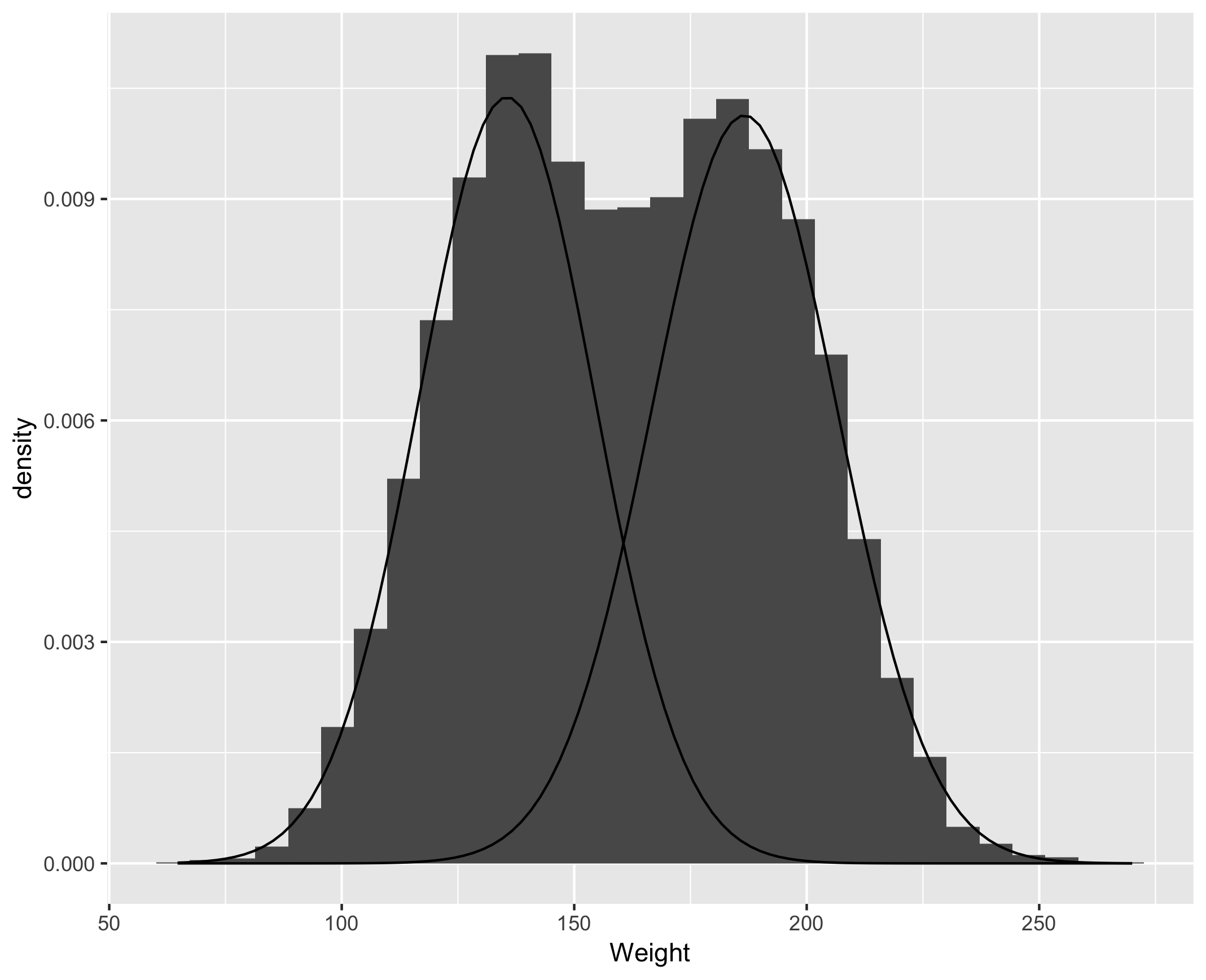Univariate Gaussian Mixture Models with flexmix
Mixture Models in R

Victor Medina
Researcher at The University of Edinburgh
gender %>%
ggplot(aes(x = Weight)) + geom_histogram(bins = 100)

Modeling with mixture models
- Which is the suitable probability distribution?
- Univariate Gaussian distributions
- How many sub-populations should we consider?
- 2 clusters
- Which are the parameters and their estimations?
- EM algorithm implemented in
flexmixto estimate the means, the standard deviations and the proportions
- EM algorithm implemented in
flexmix function
flexmix(formula, data, k, model, control, ...)
- formula: description of the model to be fit ($variable \sim 1$)
- data: data frame
- k: number of clusters
- model: specifies the distribution (
FLXMCnorm1,FLXMCmvnorm,FLXMCmvbinary,FLXMRglm,FLXMCmvpois) - control: specifies the max number of iterations, the tolerance, etc.
fit_mixture <- flexmix(Weight ~ 1, # the means and sds are constant
data = gender, # the data frame
k = 2, # the number of clusters,
model = FLXMCnorm1(), # univariate Gaussian
control = list(tol = 1e-15, # tolerance for EM stop
verbose = 1, # show partial results
iter = 1e4)) # max number of iterations
Classification: weighted
1 Log-likelihood : -48880.0782
2 Log-likelihood : -48880.0745
3 Log-likelihood : -48880.0732
4 Log-likelihood : -48880.0727
. . . . . . . .
3454 Log-likelihood : -48518.3717
3455 Log-likelihood : -48518.3717
3456 Log-likelihood : -48518.3717
3457 Log-likelihood : -48518.3717
converged
The proportions: prior function
proportions <- prior(fit_mixture)
proportions
0.4929668 0.5070332
Both distributions
parameters(fit_mixture)
Comp.1 Comp.2
coef.(Intercept) 135.54652 186.61583
sigma 18.94726 19.96097
Each of them
comp_1 <- parameters(fit_mixture, component = 1)
comp_2 <- parameters(fit_mixture, component = 2)
comp_2
Comp.2
coef.(Intercept) 186.61583
sigma 19.96097
Visualize the resulting distributions
gender %>%
ggplot() + geom_histogram(aes(x = Weight, y = ..density..)) +
stat_function(geom = "line", fun = fun_prop,
args = list(mean = comp_1[1],
sd = comp_1[2],
proportion = proportions[1])) +
stat_function(geom = "line", fun = fun_prop,
args = list(mean = comp_2[1],
sd = comp_2[2],
proportion = proportions[2]))

posterior function
posterior(fit_mixture) %>% head()
[,1] [,2]
[1,] 6.836341e-06 0.9999932
[2,] 4.421760e-01 0.5578240
[3,] 5.994160e-04 0.9994006
[4,] 1.998798e-04 0.9998001
[5,] 1.547774e-03 0.9984522
[6,] 7.544450e-01 0.2455550
clusters function
clusters(fit_mixture) %>% head()
2 2 2 2 2 1
Assignments comparison
table(gender$Gender, clusters(fit_mixture))
1 2
Female 4500 500
Male 444 4556
Let's practice!
Mixture Models in R

